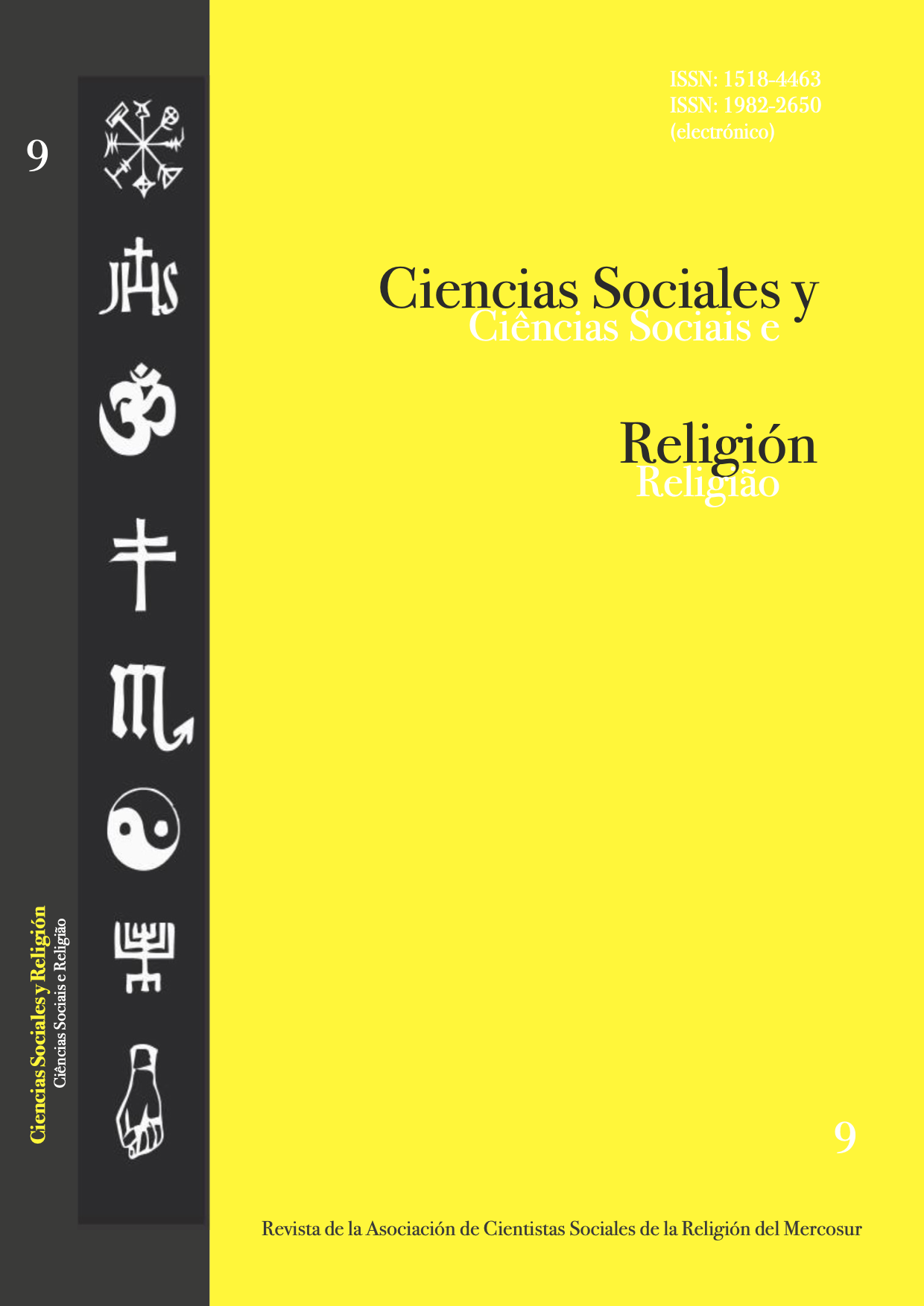Abstract
The article analyzes the conditions for the appearance and social reproduction of popular canonization, which can be defined as a spontaneous process of sanctification, neither institutionalized nor formally organized that typically emerges in cemeteries. I will do that by exploring two cases in Rio Grande do Norte, a state at the Northeastern Region of Brazil: A cangaceiro called Jararaca, in Mossoró; and an assassin called Baracho, in Natal. My aim is to understand which criteria determine the selection of these saints among the deceased buried in a cemetery; and to inquire why an outlaw becomes a saint, but not the former mayor of the city who led the victorious resistance to the invasion plotted by these same outlaws. I analyze the representations of the outlaw’s life as it is remembered and presented mainly through verbal and ritual transmission, and the representations on its posthumous existence and sainctity. I will, therefore, explore the verbal aspect of the rituals around the tomb, and the ways through which they grant symbolic efficacy to the cult (the miracles) and elaborate a memory of the outlaw’s life history. Such memory inevitably leads to another version of the history of the events that led to his death; hence, it also creates another way of telling the history of the town and its local community.
References
ARIÈS, Philippe. Essais sur l’Histoire de la Mort em Occident: du Moyen Âge a nos Jours. Paris: Éditions du Seuil, 1975.
ARIÈS, Philippe. História da Morte no Ocidente da Idade Média aos Nossos Dias. Rio de Janeiro: Ediouro, 2003 [1975].
ARIÈS, Philippe. O Homem Diante da Morte. Rio de Janeiro: Francisco Alves, 1982 [1977].
BARROS, Luitgarde Cavalcanti. A Derradeira Gesta: Lampião e Nazarenos Guerreando no Sertão. Rio de Janeiro: Faperj/Mauad, 2000.
BENJAMIN, Walter. O narrador: Considerações sobre a Obra de Nikolai Leskov. In: Obras Escolhidas. Magia e Técnica, Arte e Política. São Paulo: Brasiliense, 1996 [1936].
BLANC, Elisabeth. Héléna, la sainte du cimetière. Terrain, Mission du Patrimoine Ethnologique. Paris, no 24, pp. 33-42, Março de 1995.
BROWN, Peter. Le culte des saints. Son Essor et sa Fonction dans la Chrétienté Latine. Paris: Le Cerf, 1984.
CHANDLER, Billy Jaynes. Lampião, o Rei dos Cangaceiros. Rio de Janeiro: Paz e Terra, 1980.
DAMATTA, Roberto. A Casa e a Rua: Espaço, Cidadania, Mulher e Morte no Brasil. São Paulo: Brasiliense, 1985.
DOUGLAS, Mary. Pureza e Perigo. São Paulo: Perspectiva, 1976 [1966].
EADE, John; SALLNOW, M. J. (Orgs.). Contesting the Sacred: The Anthropology of Christian Pilgrimage. Londres: Routledge, 1991.
ECO, Umberto. Obra Aberta. São Paulo: Perspectiva, 2001.
FELIPE, José Lacerda Alves. A (Re)Invenção do Lugar: Os Rosados e o “País de Mossoró”. João Pessoa: Grafset, 2001.
FRADE, Maria de Cáscia do Nascimento. Santa de Casa: A devoção à Odetinha no cemitério São João Batista. Dissertação (Mestrado em Antropologia Social) PPGAS/Museu Nacional/UFRJ, Rio de Janeiro, 1987.
FREITAS, Eliane Tânia M. Memória, Ritos Funerários e Canonizações Populares em dois Cemitérios no Rio Grande do Norte. Tese (Doutorado em Antropologia) PPGSA/ IFCS/UFRJ, Rio de Janeiro, 2006.
FREITAS, Eliane Tânia M. Violência e sagrado: o que no criminoso anuncia o santo? Ciencias Sociales y Religión. Porto Alegre, Ano 2, No 2, Setembro de 2000.
LEACH, Edmund. Ritualization in Man: Ritualization in man in relation to conceptual and social development. In: HUXLEY, J. (Org.). Philosophical Transactions of the Royal Society of London, Series B, Biological Sciences, London, 251, p. 403-408, 1966.
LOSONCZY, Anne-Marie. Santificación popular de los muertos em cementerios urbanos colombianos. Revista Colombiana de Antropologia, Bogotá, v. 37, p. 6-23, 2001.
MARIZ, Cecília Loreto. O demônio e os pentecostais no Brasil. In: Birman P. (Org.). O Mal à Brasileira. Rio de Janeiro: Editora da UERJ, 1997.
MELLO, Frederico Pernambucano de. Guerreiros do Sol: Violência e Banditismo no Nordeste do Brasil. São Paulo: A Girafa, 2004.
NORA, Pierre. Les Lieux de Mémoire. Paris: Gallimard, 1985.
QUEIROZ, Maria Isaura Pereira de. História do Cangaço. São Paulo, Global, 1997.
RADCLIFFE-BROWN, A. Estrutura e função na sociedade primitiva. Petrópolis: Vozes, 1973.
REIS, João José. A Morte é uma Festa: Ritos Fúnebres e Revolta Popular no Brasil do Século XIX. São Paulo: Companhia das Letras, 1991.
RODRIGUES, Cláudia. Lugares dos Mortos na Cidade dos Vivos: Tradições e Transformações Fúnebres no Rio de Janeiro. Rio de Janeiro: Secretaria Municipal de Cultura/DGDIC, 1997.
SÁEZ, Oscar Calavia. Fantasmas Falados: Mitos e Mortos no Campo Religioso Brasileiro. Campinas, SP: Ed. da Unicamp, 1996.
SAHLINS, Marshall. Ilhas de História. Rio de Janeiro: Jorge Zahar, 1990 [1985].
SCHMITT, Jean-Claude. Os Vivos e os Mortos na Sociedade Medieval. São Paulo: Companhia das Letras, 1999 [1994].
SCHNEIDER, Marília. Memória e História: Antoninho da Rocha Marmo. São Paulo: T. A. Queiroz/Fapesp, 2001.
STEIL, Carlos Alberto. O Sertão das Romarias: Um Estudo Antropológico sobre o Santuário de Bom Jesus da Lapa – Bahia. Petrópolis: Vozes, 1996.
TAMBIAH, Stanley J. Leveling Crowds: Ethnonationalist Conflicts and Collective Violence in South Ásia. Berkeley: University of California Press, 1996.
TAMBIAH, Stanley J. Culture, Thought, and Social Action. An Anthropological Perspective. Cambridge, Mass.: Harvard University Press, 1985.
TRINDADE, Liana. Exu: Poder e Perigo. São Paulo: Icone, 1985a.
TRINDADE, Liana. Exu: Símbolo e Função. São Paulo: FFLCH/USP, Centro de Estudos de Religião (Coleção Religião e Sociedade), 1985b.

This work is licensed under a Creative Commons Attribution-NonCommercial-ShareAlike 4.0 International License.
Copyright (c) 2020 Eliane Tânia Freitas
